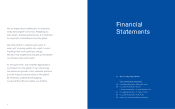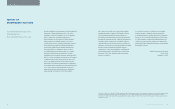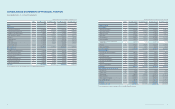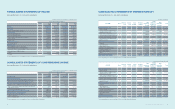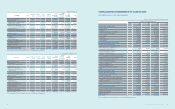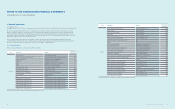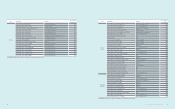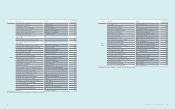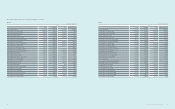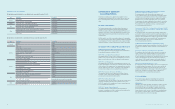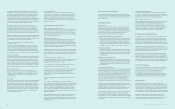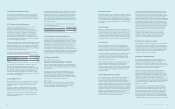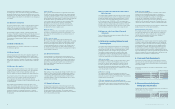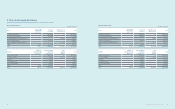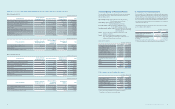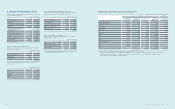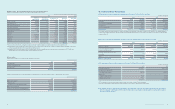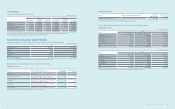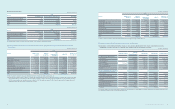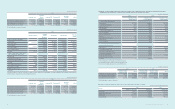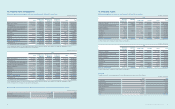Samsung 2013 Annual Report Download - page 30
Download and view the complete annual report
Please find page 30 of the 2013 Samsung annual report below. You can navigate through the pages in the report by either clicking on the pages listed below, or by using the keyword search tool below to find specific information within the annual report.
56 57
2013 SAMSUNG ELECTRONICS ANNUAL REPORT
The Company applies the acquisition method to account for business
combinations. The consideration transferred is measured at the fair values
of the assets transferred, and identiable assets acquired and liabilities
and contingent liabilities assumed in a business combination are initially
measured at their fair values at the acquisition date. The Company
recognizes any non-controlling interest in the acquiree on an acquisition-by-
acquisition basis in the event of liquidation at the non-controlling interest’s
proportionate share of the recognized amounts of acquiree’s identiable net
assets. Acquisition-related costs are expensed as incurred.
Goodwill is recognized as the excess of (1) the aggregate of i) the
consideration transferred, ii) the amount of any non-controlling interest in
the acquiree and iii) the acquisition-date fair value of the Company’s
previously held equity interest in the acquiree over (2) the net identiable
assets acquired. If the aggregate amount in (1) is less than the fair value of
the acquiree’s net assets in (2), the difference is recognized in prot or loss.
Balances of receivables and payables, income and expenses and unrealized
gains on transactions between the Company subsidiaries are eliminated.
Accounting policies of subsidiaries are changed where necessary to ensure
consistency with the policies adopted by the Company.
(B) Changes in ownership interests in subsidiaries without
change of control
Transactions with non-controlling interests that do not result in loss of
control are accounted for as equity transactions – that is, as transactions
with the owners in their capacity as owners. The difference between fair
value of any consideration paid and the relevant share acquired of the
carrying value of net assets of the subsidiary is recorded in equity. Gains or
losses on disposals to non-controlling interests are also recorded in equity.
(C) Disposal of subsidiaries
If the Company loses control of a subsidiary, any investment continuously
retained in the subsidiary is re-measured at its fair value at the date when
control is lost and any resulting differences are recognized in prot or loss.
Such fair value becomes the initial carrying amount for the subsequent
measurement of the retained interest accounted for as an associate, joint
venture, or nancial asset. In addition, any amounts previously recognized
in other comprehensive income in respect of such entity are accounted for
as if the Company had directly disposed of the related assets or liabilities.
(D) Non-controlling interests
Each component of prot or loss and other comprehensive income is
attributed to owners of the parent and to non-controlling interests. Total
comprehensive income is attributed to owners of the parent and to non-
controlling interests even if this results in a negative balance of non-
controlling interests.
(E) Associates
Associates are all entities over which the Company has signicant inuence,
generally investees of which from 20% to 50% of voting stock is owned
by the Company. Investments in associates are initially recognized at
acquisition cost using the equity method. Unrealized gains on transactions
between the Company and its associates are eliminated to the extent of
the Company’s interest in the associates. If there is any objective evidence
that the investment in the associate is impaired, the Company recognizes
the difference between the recoverable amount of the associate and
its book value as impairment loss.
(F) Joint arrangements
A joint arrangement of which two or more parties have joint control is
classied as either a joint operation or a joint venture. A joint operator has
rights to the assets, and obligations for the liabilities, relating to the joint
operation and recognizes the assets, liabilities, revenues and expenses
relating to its interest in a joint operation. A joint venturer has rights to
the net assets relating to the joint venture and accounts for that investment
using the equity method.
2.4 Foreign Currency Translation
(A) Functional and presentation currency
Items included in the nancial statements of each of the Company’s entities
are measured using the currency of the primary economic environment in
which each entity operates (the “functional currency”). The consolidated
nancial statements are presented in Korean won, which is the Company’s
functional and presentation currency.
(B) Transactions and balances
Foreign currency transactions are translated into the functional currency
using the exchange rates prevailing at the dates of the transactions or
valuation where items are re-measured. Foreign exchange gains and losses
resulting from the settlement of such transactions and from the translation
at year-end exchange rates of monetary assets and liabilities denominated
in foreign currencies are recognized in prot or loss.
Exchange differences arising on non-monetary nancial assets and liabilities
such as equity instruments at fair value through prot or loss and available-
for-sale equity instruments are recognized in prot or loss and included in
other comprehensive income, respectively, as part of the fair value gain or
loss.
(C) Translation into the presentation currency
The results and nancial position of all the foreign entities that have a functional
currency different from the presentation currency of the Company are
translated into the presentation currency as follows:
Assets and liabilities for each statement of nancial position presented are
translated at the closing rate at the end of the reporting date.
Income and expenses for each statement of income are translated at average
exchange rates, unless this average is not a reasonable approximation of
the cumulative effect of the rates prevailing on the transaction dates,
in which case income and expenses are translated at the rate on the dates of
the transactions.
All resulting exchange differences are recognized in other comprehensive
income.
On consolidation, exchange differences arising from the translation of
the net investment in foreign operations are recognized in other comprehensive
income. When a foreign operation is partially disposed of or sold, the exchange
differences that were recorded in equity are reclassied as part of gains
and losses on disposition in the statement of income. When the Company
loses control over foreign subsidiaries, the exchange differences that were
recorded in equity are reclassied into prot or loss when such gain or loss on
disposition is recognized.
Any goodwill arising on the acquisition of a foreign operation and any fair value
adjustments are treated as the foreign operation’s assets and liabilities.
Such goodwill is expressed in the foreign operation’s functional currency and
is translated at the closing rate. Exchange differences are recognized in other
comprehensive income.
2.5 Cash and Cash Equivalents
Cash and cash equivalents include cash on hand, deposits held at call
with banks, and other short-term highly liquid investments that are readily
convertible to a known amount of cash and are subject to an insignicant
risk of change in value.
2.6 Financial Assets
(A) Classication
The Company classies its nancial assets in the following categories:
nancial assets at fair value through prot or loss, loans and receivables,
available-for-sale nancial assets, and held-to-maturity nancial assets.
The classication depends on the terms of the instruments and purpose for
which the nancial assets were acquired. Management determines
the classication of its nancial assets at initial recognition.
(1) Financial assets at fair value through prot or loss
Financial assets at fair value through prot or loss are nancial assets
held for trading. A nancial asset is classied in this category if acquired
principally for the purpose of selling in the short-term. Derivatives not
subject to hedge accounting and derivatives separated from nancial
instruments such as embedded derivatives are also categorized as held
for trading. Assets in this category are classied as current assets.
(2) Loans and receivables
Loans and receivables are non-derivative nancial assets with xed or
determinable payments that are not quoted in an active market. They are
included in current assets, except for those with maturities greater than
12 months after the end of the reporting period which are classied as
non-current assets.
(3) Available-for-sale nancial assets
Available-for-sale nancial assets are non-derivatives that are either
designated in this category or not classied in any of the other categories.
They are included in non-current assets unless an investment matures
or management intends to dispose of it within 12 months of the end of
the reporting period.
(B) Recognition and measurement
Regular purchases and sales of nancial assets are recognized on the trade
date. At initial recognition, nancial assets are measured at fair value plus,
in the case of nancial assets not carried at fair value through prot or loss,
transaction costs. Transaction costs of nancial assets carried at fair value
through prot or loss are expensed in the statement of income.
After the initial recognition, available-for-sale nancial assets and nancial
assets at fair value through prot or loss are subsequently carried at
fair value. Loans and receivables and held-to-maturity investments are
subsequently carried at amortized cost using the effective interest method.
Changes in fair value of nancial assets at fair value through prot or loss
are recognized in prot or loss and changes in fair value of available-for-sale
nancial assets are recognized in other comprehensive income.
When the available-for-sale nancial assets are sold or impaired, the fair
value adjustments recorded in equity are reclassied into prot or loss.
Interest on available-for-sale nancial assets and held-to-maturity nancial
assets calculated using the effective interest method is recognized in
the statement of income as part of nance income. Dividends on available-
for-sale nancial assets are recognized in the statement of income as part of
other non-operating income when the Company’s right to receive payments
is established.
(C) Offsetting nancial instruments
Financial assets and liabilities are offset and the net amount reported in
the statement of nancial position when there is a legally enforceable right
to offset the recognized amounts and there is an intention to settle on a net
basis, or realize the asset and settle the liability simultaneously.
(D) Derecognition of nancial assets
If the Company transfers a nancial asset and the transfer does not result in
derecognition because the Company has retained substantially of all
the risks and rewards of ownership of the transferred asset due to
a recourse in the event the debtor defaults, the Company continues to
recognize the transferred asset in its entirety and recognizes a nancial
liability for the consideration received. The related nancial liability is
classied as ‘borrowings’ in the statement of nancial position.
2.7 Impairment of Financial Assets
The Company assesses at the end of each reporting period whether there
is objective evidence that a nancial asset or group of nancial assets is
impaired. A nancial asset or a group of nancial assets is impaired and
impairment loss is recognized only if there is objective evidence and that
loss event (or events) has an impact on the estimated future cash ows of
the nancial asset or group of nancial assets that can be reliably estimated.
Impairment of loans and receivables is presented as a deduction in an
allowance account. Impairment of other nancial assets is directly deducted
from their carrying amount. The Company writes off nancial assets when
the assets are determined to be no longer recoverable.
The objective evidence that a nancial asset is impaired includes signicant
nancial difculty of the issuer or obligor; a delinquency in interest or principal
payments; or the disappearance of an active market for that nancial asset
because of nancial difculties. A decline in the fair value of an available-for-sale
equity instrument by more than 20% from its cost or a prolonged decline below
its cost for more than six months is also objective evidence of impairment.
2.8 Trade Receivables
Trade receivables are amounts due from customers for merchandise sold
or services performed in the ordinary course of business. If collection is
expected in one year or less (or in the normal operating cycle of
the Company if longer), they are classied as current assets.
If not, they are presented as non-current assets. Trade receivables are
recognized initially at fair value and subsequently measured at amortized
cost using the effective interest method, less provision for impairment.
2.9 Inventories
Inventories are stated at the lower of cost and net realizable value.
Cost is determined using the average cost method, except for materials in
transit. The cost of nished goods and work in progress comprises design
costs, raw materials, direct labor, other direct costs and related production
overheads (based on normal operating capacity). It excludes costs of idle
plant and abnormal waste. Net realizable value is the estimated selling price
in the ordinary course of business, less applicable variable selling expenses.
Inventories are reduced for the estimated losses arising from excess,
obsolescence, and decline in value. This reduction is determined by
estimating market value based on future customer demand. The losses on
inventory obsolescence are recorded as a part of cost of sales.


